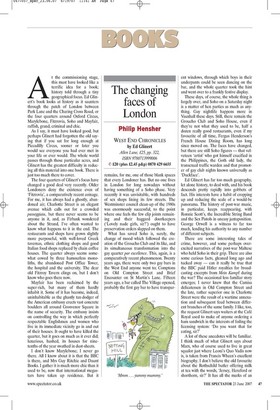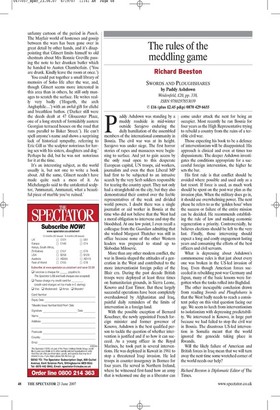The changing faces of London
Philip Hensher WEST END CHRONICLES by Ed Glinert Allen Lane, £25, pp. 322, ISBN 9780713999006 © £20 (plus £2.45 p&p) 0870 429 6655 At the commissioning stage, this must have looked like a terrific idea for a book; history told through a tiny geographical focus. Ed Glinert's book looks at history as it saunters through the patch of London between Park Lane and the Charing Cross Road, or the four quarters around Oxford Circus, Marylebone, Fitzrovia, Soho and Mayfair, raffish, grand, criminal and chic.
As I say, it must have looked good, but perhaps Glinert had forgotten the old saying that if you sat for long enough at Piccadilly Circus, sooner or later you would see everyone you had ever met in your life or ever would. The whole world passes through those particular acres, and Glinert has the greatest difficulty in reducing all this material into one book. There is just too much there to cover.
The four quarters of Glinert's focus have changed a good deal very recently. Older Londoners deny the existence even of `Fitzrovia', a comparatively recent coinage. For me, it has always had a ghostly, abandoned air; Charlotte Street is an elegant avenue which calls out for a crowded passeggiata, but there never seems to be anyone in it, and, as Firbank wondered about the Strand, I've often wanted to know what happens to it in the end. The restaurants and shops have grown slightly more purposeful, with well-loved Greek tavernas, ethnic clothing shops and good Italian food shops replaced by chain coffee houses. The quarter always seems somewhat cowed by three humourless monoliths, the abandoned Post Office Tower, the hospital and the university. The dear old Fitzroy Tavern clings on, but I don't know who goes there now.
Mayfair has been reclaimed by the super-rich, but many of them hardly inhabit it. Some of it has become, indeed, uninhabitable as the ghastly tax-dodger of the American embassy erects vast concrete boulders all around Grosvenor Square in the name of security. The embassy insists on controlling the way in which perfectly respectable Englishmen and women who live in its immediate vicinity go in and out of their houses. It ought to have killed the quarter, but it goes on much as it ever did; luxurious, hushed, its houses for ninetenths of the year swathed in dust-sheets.
I don't know Marylebone; I never go there. All I know about it is that the BBC is there, and Mrs Guy Ritchie and Daunt Books. I gather it is much more chic than it used to be, now that international megastars have taken up residence. But it remains, for me, one of those blank spaces that every Londoner has. But no one lives in London for long nowadays without having something of a Soho phase. Very recently it was unvisitable, with hundreds of sex shops lining its few streets. The Westminster council clean-up of the 1980s was enormously successful, to the point where one feels the few clip joints remaining and their haggard doorkeepers (Lovely nude girls, sir?') ought to have preservation orders slapped on them.
What has saved Soho is, surely, the change of mood which followed the creation of the Groucho Club and its like, and its simultaneous transformation into the gay quarter par excellence. This, again, is a comparatively recent phenomenon. Twenty years ago, there were only two gay bars in the West End anyone went to; Comptons on Old Compton Street and Brief Encounter on St Martin's Lane. Fifteen years ago, a bar called The Village opened, probably the first gay bar to have transparent windows, through which boys in their underpants could be seen dancing on the bar, and the whole quarter took the hint and went over to a frankly festive display.
These days, of course, the whole thing is largely over, and Soho on a Saturday night is a matter of hen parties as much as anything. Gay nightlife happens more in Vauxhall these days. Still, there remain the Groucho Club and Soho House, even if they're not what they used to be, half a dozen really good restaurants, even if my favourite of all time, Fergus Henderson's French House Dining Room, has long since moved on. The faces have changed, but there are still Soho figures — that velveteen 'artist' who got himself crucified in the Philippines, the Goth old lady, the transexual traffic warden and that promoter of gay club nights known universally as Duckface'.
Ed Glinert has far too much geography, let alone history, to deal with, and his book descends pretty rapidly into gobbets of fact. His interests have a habit of cropping up and reducing the scale of a would-be panorama. The history of post-war music, in particular, keeps reappearing, with Ronnie Scott's, the Incredible String Band and the Sex Pistols in uneasy juxtaposition. George Orwell is a witness to far too much, lending his authority to any number of different subjects.
There are some interesting tales of crime, however, and some perhaps overexcited narratives of the post-war Maltese who held Soho in their grip. There are also some curious facts, gleaned long ago and tucked away — can it really be true that the BBC paid Hitler royalties for broadcasting excerpts from Mein Kampf during the war? The occasional less familiar story emerges; I never knew that the Camisa delicatessen in Old Compton Street and the late, rather superior one in Charlotte Street were the result of a wartime annexation and subsequent feud between different branches of the same family. I like, too, the request Glinert says waiters at the Café Royal used to make of anyone ordering a ham sandwich in the interests of foiling the licensing system: 'Do you want that for eating, sir?'
A lot of these anecdotes will be familiar. I think much of what Glinert says about Marx, who of course used to live in great squalor just where Leoni's Quo Vadis now is, is taken from Francis Wheen's excellent biography. I don't believe the old favourite about the Rothschild butler offering milk at tea with the words, 'Jersey, Hereford or shorthorn, sir?' It has all the marks of an unfunny cartoon of the period in Punch. The Mayfair world of hostesses and gossip between the wars has been gone over in great detail by other hands, and it's disappointing that Glinert limits himself to old chestnuts about Mrs Ronnie Greville passing the note to her drunken butler which he handed to Austen Chamberlain. (You are drunk. Kindly leave the room at once.') You could put together a small library of memoirs of Soho life after the war, and, though Glinert seems more interested in this area than in others, he still only manages to scratch the surface. He writes really very badly (Hogarth, the arch Anglophile...') with an awful gift for cliché and breathless bathos. (Darker still were the deeds dealt at 47 Gloucester Place, one of a long stretch of formidably austere Georgian terraced houses on the road that runs parallel to Baker Street.'). He can't spell anyone's name and shows a surprising lack of historical sympathy, referring to Eric Gill as 'the sculptor notorious for having sex with his sisters, daughters and dog.' Perhaps he did, but he was not notorious for it at the time.
It's an interesting subject, as the world usually is, but not one to write a book about. All the same, Glinert needn't have made quite such a mess of it. As Michelangelo said to the untalented sculptor, Ammanati, Ammanati, what a beautiful piece of marble you've ruined.'






























































 Previous page
Previous page